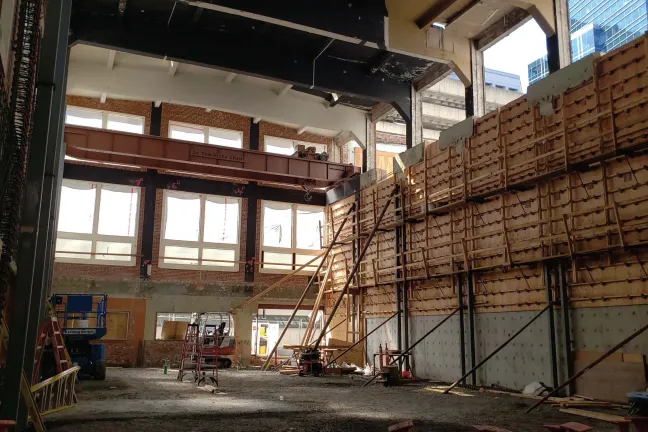Construction of Multnomah County’s new 17-story Central Courthouse is on schedule and on budget one year before its grand opening in 2020, project managers told the Board of County Commissioners at a June 27 briefing.
“We’ve spent about $225 million out of our total budget of $324 million,” county project manager JD Deschamps explained. That investment can be seen in the new building taking shape at the west end of the Hawthorne Bridge. Deschamps said recent construction milestones include:
Completing installation of the building’s windows and sprinkler system
Framing out interiors up to the 15th floor
Installing wall and ceiling wood paneling in the first courtrooms
Removing the construction crane in July
“On the roof we have installed solar panels and nearly all of the building’s mechanical system, which will be tested this summer,” said Deschamps. He said the building will be commissioned (or begin operating) floor by floor, starting with the penthouse mechanical system this summer.
Deschamps described some of the building’s energy saving features under construction, such as radiant floor heating in which daylight warms tubes of water under each floor that circulate to heat the shady side of the building. Each courtroom will also has clerestory windows to bring daylight into the room.
The historic Jefferson Station building that shares the courthouse block is being seismically reinforced so it can house high volume courtrooms that handle traffic violations and small claims, Deschamps explained. He said that the State Historic Preservation Office recently voted not to support a request to remove the building from the National Register of Historic Places. Deschamps said the county opposed removing the building from the Register and will preserve the building’s most significant historic features.
Hoffman Construction project manager Justin Paterson explained how the courthouse project is creating opportunities for firms owned by minorities, women and other disadvantaged business owners as well as employing a diverse team of trades workers.
“Our project goal was to contract 20% of the construction budget to COBID firms,” Paterson said, which includes businesses owned by minorities, women, service-disabled veterans, and emerging small businesses. “We are tracking over 30% at this time, with the project 67% complete,” he noted. The contracts awarded to those firms totals more than $64 million.
The workers constructing the building also represent the diversity of the Portland region, thanks to the project team’s efforts to bring new workers into the building trades. “Our goal is for 20% of work hours to be by apprentices and we are currently at 29%,” said Paterson. “The overall participation of minority males in the project is at 25.8% and women make up 10.4% of our workforce.”
“We set an aggressive goal for 25% of our apprentices to be women, when only about 6% of the local construction workforce is female,” Paterson said. “By working with partners like Oregon Tradeswomen, we are watching our total go up each month.”
Hoffman Construction and Oregon Tradeswomen chose the Central Courthouse project to launch a new initiative designed to make the construction workplace more welcoming to women, minorities and new workers.
“The Green Dot program started on college campuses to reduce sexual assaults, and has been used by the military,” Paterson explained. “This is the first time the program has been used on any construction project.”
“Green Dot is based on the concepts that harassment, hazing and bullying are not OK and that everyone will do their part to eliminate these practices,” Paterson said. “We developed a curriculum and have trained about one hundred workers. We use realistic strategies and the power of peer pressure. Even something as subtle as a look from a respected coworker after someone says something inappropriate can send a message of what is not acceptable in the workplace.”
“We have a supportive owner in Multnomah County that is helping us roll out this new program,” Paterson said.
Kelly Haines with Work Systems Inc. explained how community partners are teaming with the project to recruit apprentices from groups that have been under-represented in construction. “We are helping local people go from not being able to buy diapers for their children in some cases to earning a good living and a pension.”
“So far we have trained 128 people in our pre-apprenticeship program, more than twice our original goal,” Haines said. “One hundred percent of our trainees were low income residents. It’s a testament to our network of local providers and finding economies of scale in our training by having multiple agencies involved.” Haines said the program recently added POIC, a non-profit with a long history of working with Portland’s African American community. She said this will help expand recruitment of African Americans into pre-apprenticeship programs.
“At the county, we’re building things, but it’s equally important how we build them,” County Chair Deborah Kafoury told the presenters. “The new courthouse is changing the Portland skyline. Thanks for making the building beautiful and changing peoples’ lives in the process.”


